Hold down the T key for 3 seconds to activate the audio accessibility mode, at which point you can click the K key to pause and resume audio. Useful for the Check Your Understanding and See Answers.
The Doppler effect is a phenomenon observed whenever the source of waves is moving with respect to an observer. The Doppler effect can be described as the effect produced by a moving source of waves in which there is an apparent upward shift in frequency for the observer and the source are approaching and an apparent downward shift in frequency when the observer and the source is receding. The Doppler effect can be observed to occur with all types of waves - most notably water waves, sound waves, and light waves. The application of this phenomenon to water waves was discussed in detail in Unit 10 of The Physics Classroom Tutorial. In this unit, we will focus on the application of the Doppler effect to sound.
We are most familiar with the Doppler effect because of our experiences with sound waves. Perhaps you recall an instance in which a police car or emergency vehicle was traveling towards you on the highway. As the car approached with its siren blasting, the pitch of the siren sound (a measure of the siren's frequency) was high; and then suddenly after the car passed by, the pitch of the siren sound was low. That was the Doppler effect - a shift in the apparent frequency for a sound wave produced by a moving source.
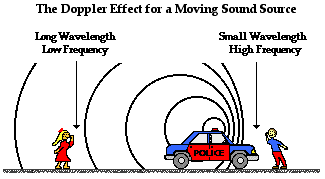
Another common experience is the shift in apparent frequency of the sound of a train horn. As the train approaches, the sound of its horn is heard at a high pitch and as the train moved away, the sound of its horn is heard at a low pitch. This is the Doppler effect.
A common Physics demonstration the use of a large Nerf ball equipped with a buzzer that produces a sound with a constant frequency. The Nerf ball is then thrown around the room. As the ball approaches you, you observe a higher pitch than when the ball is at rest. And when the ball is thrown away from you, you observe a lower pitch than when the ball is at rest. This is the Doppler effect.
Explaining the Doppler Effect
The Doppler effect is observed because the distance between the source of sound and the observer is changing. If the source and the observer are approaching, then the distance is decreasing and if the source and the observer are receding, then the distance is increasing. The source of sound always emits the same frequency. Therefore, for the same period of time, the same number of waves must fit between the source and the observer. if the distance is large, then the waves can be spread apart; but if the distance is small, the waves must be compressed into the smaller distance. For these reasons, if the source is moving towards the observer, the observer perceives sound waves reaching him or her at a more frequent rate (high pitch). And if the source is moving away from the observer, the observer perceives sound waves reaching him or her at a less frequent rate (low pitch). It is important to note that the effect does not result because of an actual change in the frequency of the source. The source puts out the same frequency; the observer only perceives a different frequency because of the relative motion between them. The Doppler effect is a shift in the apparent or observed frequency and not a shift in the actual frequency at which the source vibrates.
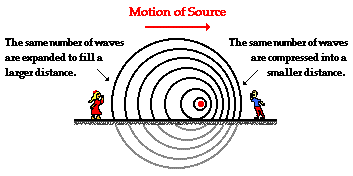
Shock Waves and Sonic Booms
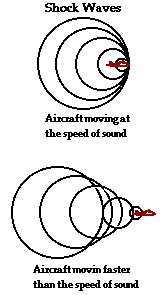 The Doppler effect is observed whenever the speed of the source is moving slower than the speed of the waves. But if the source actually moves at the same speed as or faster than the wave itself can move, a different phenomenon is observed. If a moving source of sound moves at the same speed as sound, then the source will always be at the leading edge of the waves that it produces. The diagram at the right depicts snapshots in time of a variety of wavefronts produced by an aircraft that is moving at the same speed as sound. The circular lines represent compressional wavefronts of the sound waves. Notice that these circles are bunched up at the front of the aircraft. This phenomenon is known as a shock wave. Shock waves are also produced if the aircraft moves faster than the speed of sound. If a moving source of sound moves faster than sound, the source will always be ahead of the waves that it produces. The diagram at the right depicts snapshots in time of a variety of wavefronts produced by an aircraft that is moving faster than sound. Note that the circular compressional wavefronts fall behind the faster moving aircraft (in actuality, these circles would be spheres).
The Doppler effect is observed whenever the speed of the source is moving slower than the speed of the waves. But if the source actually moves at the same speed as or faster than the wave itself can move, a different phenomenon is observed. If a moving source of sound moves at the same speed as sound, then the source will always be at the leading edge of the waves that it produces. The diagram at the right depicts snapshots in time of a variety of wavefronts produced by an aircraft that is moving at the same speed as sound. The circular lines represent compressional wavefronts of the sound waves. Notice that these circles are bunched up at the front of the aircraft. This phenomenon is known as a shock wave. Shock waves are also produced if the aircraft moves faster than the speed of sound. If a moving source of sound moves faster than sound, the source will always be ahead of the waves that it produces. The diagram at the right depicts snapshots in time of a variety of wavefronts produced by an aircraft that is moving faster than sound. Note that the circular compressional wavefronts fall behind the faster moving aircraft (in actuality, these circles would be spheres).
If you are standing on the ground when a supersonic (faster than sound) aircraft passes overhead, you might hear a sonic boom. A sonic boom occurs as the result of the piling up of compressional wavefronts along the conical edge of the wave pattern. These compressional wavefronts pile up and interfere to produce a very high-pressure zone. This is shown below. Instead of these compressional regions (high-pressure regions) reaching you one at a time in consecutive fashion, they all reach you at once. Since every compression is followed by a rarefaction, the high-pressure zone will be immediately followed by a low-pressure zone. This creates a very loud noise.
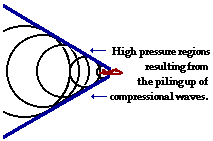
If you are standing on the ground as the supersonic aircraft passes by, there will be a short time delay and then you will hear the boom - the sonic boom. This boom is merely a loud noise resulting from the high pressure sound followed by a low pressure sound. Do not be mistaken into thinking that this boom only happens the instant that the aircraft surpasses the speed of sound and that it is the signature that the aircraft just attained supersonic speed. Sonic booms are observed when any aircraft that is traveling faster than the speed of sound passes overhead. It is not a sign that the aircraft just overcame the sound barrier, but rather a sign that the aircraft is traveling faster than sound.
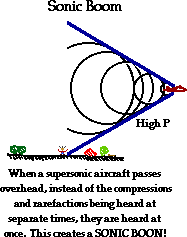
Investigate!
Use the Doppler Effect widget below to investigate the effect of the speed of an object upon the amount of Doppler shifting that occurs when the source of sound moves away from the observer. Enter the source frequency and the source speed. Then click the Submit button to view the observed frequency. Note that the observed frequency is less than the source frequency. Experiment with various values of source frequency and speed.
Check Your Understanding
1. Suppose you are standing on the passenger-loading platform of the commuter railway line. As the commuter train approaches the station, it gradually slows down. During this process of slowing down, the engineer sounds the horn at a constant frequency of 300 Hz. What pitch or changes in pitch will you perceive as the train approaches you on the loading platform?